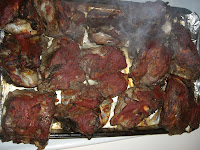When we started digging through the book, we noticed one commonality: they all start with a generous dose of veal demi-glace. Not just a splash that we could replace with beef stock, mind you. In most cases, the majority of the sauce (volumetrically) was meant to be comprised of this rich, thick, silky nectar of the gods. So, rather than abandon all ‘sauce man’ dreams, we made a fateful decisions: we’d make our own natural demi*.
After doing a great deal of research (since that’s Allie’s job, and Ben’s just a huge dork), we ended up putting together a recipe (which follows) that was a combination of what Michael Ruhlman describes in Ratio (which is Ben’s new favorite book), Thomas Keller describes in The French Laundry Cookbook, and an instructional video that we found on this website. And, sure enough, after many hours of reduction and re-reduction, we ended up with a few pounds of beautiful, beautiful demi. It definitely involved a time (~20 hours total cook time) and financial (~50 bucks) investment, but in the end, our freezer now contains 27 little blocks of deliciousness…
*The ‘classic’ demi is made by reducing a combination of veal stock and sauce espagnole (which itself is a mixture of veal stock and a dark roux). A ‘natural’ demi leaves out the roux (which thickens the sauce in less time and increases yield because you don’t need to reduce your veal stock as far). For our first demi, we figured we’d go au natural… maybe next time we’ll try it with roux and see if we can tell the difference.
NATURAL VEAL DEMI GLACE
Ingredients
- 12 lbs veal bones (if frozen, thaw them)
- 1 can tomato paste
- Olive Oil
- 3 carrots
- 3 stalks celery
- 2 leeks
- 2 Spanish onions
- 1 head garlic
- 1 T peppercorns
- 3 sprigs thyme
- 4 bay leaves
- Little Red wine (for deglazing)
Directions
- Preheat oven to 450.
- Oil the bottom of a baking sheet and arrange bones on it in a single layer (preferably with enough room for them to roast rather than steam).
- Roast bones for 45 minutes.
- While bones are roasting, prepare veggies by roughly chopping them into 1-2 inch chunks (don’t worry about removing skin/peels).
- Pull out bones, flip them over, and brush with the tomato paste.
- Roast for another 15 minutes.
- Pull bones from oven, put into stock pot(s), and add ~3 cups of water for every pound of bones (should be enough to cover bones by a few inches).
- Pour fat off roasting pan, and put back into the oven for a few minutes until the fond caramelizes a little more, then deglaze with red wine and add to stock.
- Put stock pots onto medium high heat until they come to a simmer, skimming off gunk from time to time with a small strainer.
- Once simmering, add veggies and spices, then ensure that the heat stays between 190 to 200 degrees for the next 8 hours or so, or until the liquid is reduced to half. You now have a veal stock!

- Using a china cap or colander, strain away all of the solids, then remove the fat from the resulting liquid (one trick here is to allow the stock to come to come to room temperature, then refrigerate it. After it cools, it should be pretty gelatinous, and you can scrape the layer of fat off the top).
- After you’ve removed the fat, put the stock back onto the stove, and reduce it by half again. You now have a natural demi!
- Pour the demi through a fine mesh strainer and into a baking pan, allowing it to cool then refrigerating.
- Cut the gelatinous demi into blocks, then wrap and refrigerate them.
- From what we hear, they can last several months in the freezer.







No comments:
Post a Comment